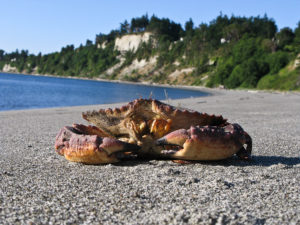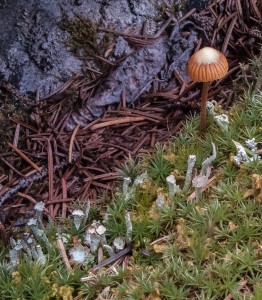Morning light
dissolved in salty water
flows in on the tide.
 Walking along the beach one morning I found this poor fellow stranded on the sand, far from the tideline ,still on it’s way out. I feel a bit like him, 500 miles from the familiar mountains of home.
Walking along the beach one morning I found this poor fellow stranded on the sand, far from the tideline ,still on it’s way out. I feel a bit like him, 500 miles from the familiar mountains of home.
For days now I have wandered Port Townsend’s long empty beach, fascinated by the salt rimed grasses with their lance sharp leaves cutting through the sand, the calligraphy of seal prints that tell the story of late night forages for food, and the twisted, sea bleached driftwood that has traveled, maybe as far as I have, from where it grew.
Everything is new to me here. I don’t know the names of the shells that lie wave broken on the beach or the lifecycles of the creatures that called them home. Every walk is an adventure and my pockets bulge with bits of sea glass, the occasional half shell still in one piece and iridescent with pale green and blue luster, and whatever bits of floatsum and jetsum that catches my eye. I will make a little arrangement on my desk so that I can appreciate them as I work. It is part of the nesting process I suppose, this urge to create a home, however temporary, in the place you find yourself.
But like the crab, who waves a dispirited claw at me, I am still very conscious of the fact that this is not my home ground. I will always feel “out of place” by the sea. For ten years I lived in Tacoma, happy enough with my family and friends and job, but deep down inside there was a longing, a longing made more intense by the endless grey months of rain, to get back to the mountains where I grew up. To get back to the snow. To get back to brown hills that were not clogged with undergrowth so thick it felt threatening sometimes.
I think everyone has a landscape where they feel as if they have come home. Sometimes it is the place where they grew up, but sometimes they must search until they find that place that sings to their soul. My friend Natasha grew up in London, but inexplicably feels bound to the mountains of Montana. She came, as John Denver said in a song, “home to place I’d never been before.”
My husband, on the other hand grew up by the sea, and after we moved to Montana, he must have felt the same longing I had, but instead it was for rhythm of tides and the smell of briny air and the endless expanse of water where he could roam free in his boat . I am amazed in the generosity of his spirit that he was able to leave the seascape he loves so much, and to be satisfied with no more than regular visits back. Perhaps when we first meet someone we should ask, not what their sign is, but what their landscape is. What is your landscape?
 There is a place in the backwoods, down near the river where the trees open into a clearing and the clearing is carpeted in moss. I refer to it as the dying place because often when I go back there a new deer carcass has appeared, hide and bones scattered here and there. It feels like a sacred place, but not a sad place. In spite of the death that happens here, it is such a beautiful, gently quiet place. It’s the perfect place to sit on the soft cushion of moss and listen to the river and watch the herons going back and forth from the rookery, sometimes with gleaming fish in their needle long beaks.
There is a place in the backwoods, down near the river where the trees open into a clearing and the clearing is carpeted in moss. I refer to it as the dying place because often when I go back there a new deer carcass has appeared, hide and bones scattered here and there. It feels like a sacred place, but not a sad place. In spite of the death that happens here, it is such a beautiful, gently quiet place. It’s the perfect place to sit on the soft cushion of moss and listen to the river and watch the herons going back and forth from the rookery, sometimes with gleaming fish in their needle long beaks.
It is also an ideal place to get lost in the miniature world of the moss forest. Robin Wall Kimmerer’s book Gathering Moss has opened my eyes to the complex ecosystem under my feet and opened my mind to a new way of relating to the natural world. Her book is a combination of science and personal reflection, born out of her life as both a scientist and as a Native American writer who experiences the world within the framework of indigenous ways of knowing.
She writes: “In indigenous ways of knowing, we say that a thing cannot be understood until it is know by all four aspects of our being: mind, body, emotion, and spirit. The scientific way of knowing relies only on empirical information from the world, gathered by body and interpreted by mind. In order to tell the mosses’ story I need both approaches, objective and subjective. These essays intentionally give voice to both ways of knowing, letting matter and spirit walk companionably side by side. And sometimes even dance.”
With her encouragement I have taken small samples of the moss back to the house and placed them under the microscope, which allows me to wander at will through the stems, branches and leaves of the moss. There I have an ant’s eye perspective and I’m able to wander in this intimate forest, not in search of answers to any specific questions, but as an explorer open to whatever discoveries I might stumble upon. This is the joy of being an amateur naturalist and not a professional scientist. I am not trying to probe and prod data from the moss, I am simply listening to whatever it has to tell me. I love what Kimmerer says about learning in traditional indigenous communities.
“Learning takes a form very different from that in the American public education system. Children learn by watching, by listening, and by experience. They are expected to learn from all members of the community, human and non. To ask a direct question is often considered rude. Knowledge cannot be taken; it must be given…Much learning takes place by patient observation, discerning pattern and its meaning by experience.”
As I peered into the world revealed under the microscope’s lens, I found a different way of learning, “to let the mosses tell their story, rather than wring it from them.” It is way of learning I hope to carry out into my other explorations of the backwoods and beyond.